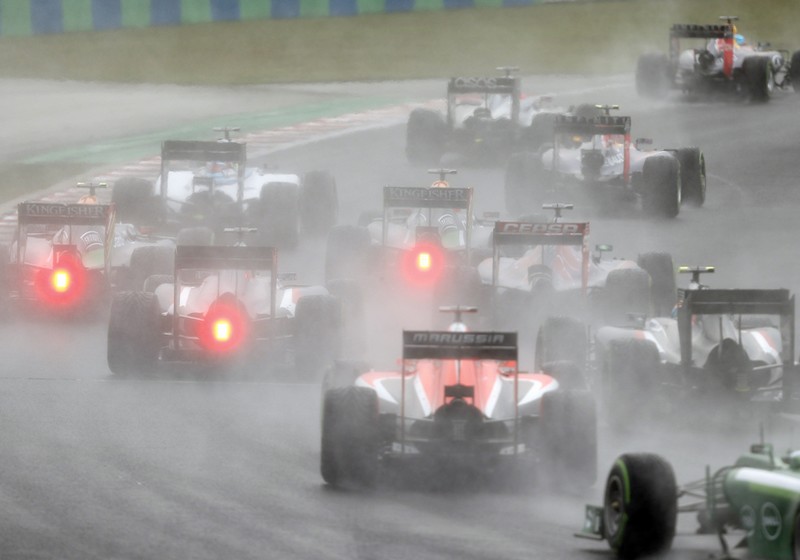After a poor turnout at Hockenheim for last week’s German Grand Prix and in a period of gentle decline for Formula One’s global television ratings, Formula One chief executive Bernie Ecclestone convened a meeting of team principals on Saturday morning in Hungary to discuss ways of ‘improving the show’.
There were no formal announcements afterwards but news did leak out that Flavio Briatore, the former Benetton and Renault team principal, will be playing a bigger role in marketing the sport from now on. There were also murmurs that there had been a favourable reaction amongst teams to the idea of introducing success ballast – literally adding weight to cars that win – into Formula One at some point in the future, suggesting that the habit of senior figures in the sport making knee-jerk and flawed changes is set to continue.
What nobody at a senior level in the sport appears to have grasped is that the constant tinkering with rules over the past few years – the much-discussed drag reduction system (DRS), double points at the final race and standing starts instead of safety car restarts to name but three gimmicky additions to Formula One – has alienated existing fans and failed to attract new ones. Indeed, non-Formula One fans tend to find the sport’s constant changes amusing rather than a reason to tune in. It all suggests a huge lack of belief in the product and, Sunday’s superb Grand Prix showed, there is nothing at all wrong with the Formula One show.
The problem – and do forgive the repetition, as this has been a theme of these diaries this season – is the lack of communication about the product, which stems from Formula One’s lack of centralised marketing. Put simply, how can you expect to sell the best product in the world if nobody knows about it?
It is nothing short of embarrassing that such a well-established global sport does not, in 2014, have a forward-facing, active PR department, assisting the teams (who do an excellent job), broadcasters (likewise) and local race promoters (who get such a small amount of the pie they are hamstrung from the off).
When Christian Horner, Red Bull Racing’s team principal, attacked the media during Friday’s team principals’ press conference for asking negative questions, he badly missed the point. It is not the media’s responsibility to promote the sport, it is Formula One’s. Horner’s ire should have been directed at Ecclestone and Formula One Management, who, bafflingly, have never invested in a proper marketing team to sell the sport they hold the commercial rights to.
That a bigger role for Briatore, who has a marketing brain but is a close confidant of Ecclestone and, frankly, yesterday’s man, appears to have been agreed at Saturday’s meeting, rather suggests that Horner didn’t have quite the same confidence to confront Ecclestone as he did the press. That, sadly, is no surprise.
Feeling the force
The financial benefits of finishing high up in the constructors’ world championship are well-known and at the halfway stage of the year Williams, who lie fourth after finishing ninth last season, appear to be in line for the largest increase in revenue. But beyond the money, and despite a disastrous race in Hungary, which saw Nico Hulkenberg crash into Sergio Perez and Perez crash into the wall, Force India’s excellent start to the season could be a game-changer for the team. As it stands, the fifth-place team will replace Lotus, which currently languishes in eighth, in Formula One’s controversial Strategy Group. Much to the annoyance of the smaller teams, the Strategy Group is made up of only six teams – Mercedes, Red Bull, McLaren, Ferrari, Williams and the next best-placed team in the world championship. The group meets to discuss ideas and can forward proposals to the full Formula One Commission, where all the teams are represented. As long as it stays ahead of Lotus, which currently holds a Strategy Group seat, Force India is poised to become a much more influential voice in the sport.
Blue Sky thinking?
BSkyB’s announcement last week that it will pay around UK£4.9 billion to acquire 57.4 per cent of Rupert Murdoch-owned Sky Deutschland and full control of Sky Italia may, in time, have an impact on how Formula One is broadcast. Formula One is a key element in the sports rights portfolios of Sky in the UK, Germany and Italy, with the pay television services each running bespoke channels and live, fully interactive, coverage of every Grand Prix. Sky Deutschland’s coverage is the most established, with Sky Sports in the UK beginning its Formula One deal in 2012 and Sky Italia following suit a year later. Currently, all three channels run completely separately with three production and editorial teams sent to every race. With all three coming under the same ownership, there is likely to be focus on streamlining and pooling editorial resources. “The enlarged group will be able to share programming, channel brands and creative across territories, as well as to be more effective in the production of live cross-border events, such as Formula One, where all three broadcasters each currently send their own set for production capability,” confirmed BSkyB’s chief financial officer Andrew Griffith, speaking during BSkyB’s full year results conference call last week.

